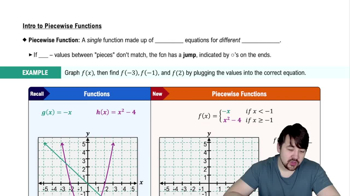Table of contents
- 0. Functions7h 52m
- Introduction to Functions16m
- Piecewise Functions10m
- Properties of Functions9m
- Common Functions1h 8m
- Transformations5m
- Combining Functions27m
- Exponent rules32m
- Exponential Functions28m
- Logarithmic Functions24m
- Properties of Logarithms34m
- Exponential & Logarithmic Equations35m
- Introduction to Trigonometric Functions38m
- Graphs of Trigonometric Functions44m
- Trigonometric Identities47m
- Inverse Trigonometric Functions48m
- 1. Limits and Continuity2h 2m
- 2. Intro to Derivatives1h 33m
- 3. Techniques of Differentiation3h 18m
- 4. Applications of Derivatives2h 38m
- 5. Graphical Applications of Derivatives6h 2m
- 6. Derivatives of Inverse, Exponential, & Logarithmic Functions2h 37m
- 7. Antiderivatives & Indefinite Integrals1h 26m
- 8. Definite Integrals4h 44m
- 9. Graphical Applications of Integrals2h 27m
- 10. Physics Applications of Integrals 2h 22m
2. Intro to Derivatives
Derivatives as Functions
Problem 77a
Textbook Question
Graph the function .
 Verified step by step guidance
Verified step by step guidance1
Step 1: Understand the piecewise function. The function f(x) is defined in two parts: f(x) = x for x ≤ 0 and f(x) = x + 1 for x > 0.
Step 2: Graph the first part of the function, f(x) = x, for x ≤ 0. This is a straight line through the origin with a slope of 1, but only for x-values less than or equal to 0.
Step 3: Graph the second part of the function, f(x) = x + 1, for x > 0. This is a straight line with a slope of 1, starting at the point (0, 1) and continuing for x-values greater than 0.
Step 4: Identify the point of transition at x = 0. For x = 0, the function value is 0 from the first part, so the point (0, 0) is included in the graph.
Step 5: Combine the two parts on the same set of axes. Ensure the graph is continuous at x = 0, with a closed circle at (0, 0) and an open circle at (0, 1) to indicate the transition between the two parts.
 Verified video answer for a similar problem:
Verified video answer for a similar problem:This video solution was recommended by our tutors as helpful for the problem above
Video duration:
3mPlay a video:
Was this helpful?
Key Concepts
Here are the essential concepts you must grasp in order to answer the question correctly.
Piecewise Functions
A piecewise function is defined by different expressions based on the input value. In this case, the function f(x) has two cases: for x less than or equal to 0, it equals x, and for x greater than 0, it equals x + 1. Understanding how to evaluate and graph these distinct segments is crucial for visualizing the overall function.
Recommended video:

Piecewise Functions
Graphing Techniques
Graphing techniques involve plotting points and understanding the behavior of functions across different intervals. For piecewise functions, it is essential to identify the points where the function changes its definition, ensuring that the graph accurately reflects the function's behavior at those transition points.
Recommended video:

Graphing The Derivative
Continuity and Discontinuity
Continuity refers to a function being unbroken and having no gaps in its graph. In the case of the given piecewise function, it is important to check if the function is continuous at x = 0, where the definition changes. Analyzing limits and function values at this point helps determine if there is a jump or removable discontinuity.
Recommended video:

Intro to Continuity
Related Videos
Related Practice




